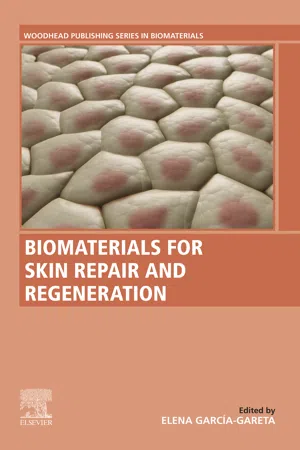
- 372 pages
- English
- ePUB (mobile friendly)
- Available on iOS & Android
Biomaterials for Skin Repair and Regeneration
About This Book
Biomaterials for Skin Repair and Regeneration examines a range of materials and technologies used for regenerating or repairing skin. With a strong focus on biomaterials and scaffolds, the book also examines the testing and evaluation pathway for human clinical trials.
Beginning by introducing the fundamentals on skin tissue, the book goes on to describe contemporary technology used in skin repair as well as currently available biomaterials suitable for skin tissue repair and regeneration. Skin tissue engineering and the ideal requirements to take into account when developing skin biomaterials are discussed, followed by information on the individual materials used for skin repair and regeneration. As evaluation of biomaterials in animal models is mandatory before proceeding into human clinical trials, the book also examines the different animal models available.
With a strong focus on materials, engineering, and application, this book is a valuable resource for materials scientists, skin biologists, and bioengineers with an interest in tissue engineering, regeneration, and repair of skin.
- Provides an understanding of basic skin biology
- Comprehensively examines a variety of biomaterial approaches
- Looks at animal models for the evaluation of biomaterial-based skin constructs
Frequently asked questions
Information
Skin biology
Abstract
Keywords
1.1. Skin function
1.2. Skin layers
1.2.1. Epidermis

1.2.1.1. Keratinocytes
Table of contents
- Cover image
- Title page
- Table of Contents
- Copyright
- List of contributors
- Introduction to biomaterials for skin repair and regeneration
- Part One. Introduction
- Part Two. Biomaterials for skin scaffolds
- Part Three. In vivo evaluation of new biomaterials for skin scaffolds
- Index